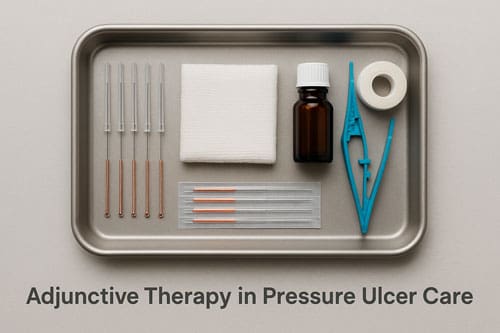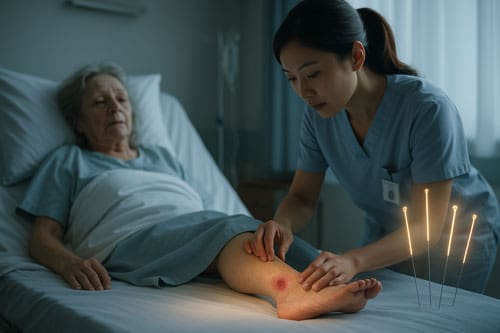Acupuncture In The Treatment Of Pressure Ulcers

Pressure ulcers, also known as pressure sores or bedsores, are localized tissue injuries affecting bone, tendon, and muscle, with a global prevalence estimated at 12.8%–26.5%. They often develop when someone stays in one position for too long without shifting their weight, leading to reduced blood flow to the area. This lack of blood flow can result in tissue damage and ultimately the formation of pressure ulcers.
These ulcers commonly occur in areas where bones are close to the skin, such as the hips, heels, elbows, and lower back. People who are bedridden or have mobility issues are at higher risk of developing pressure ulcers, as are those with medical conditions that affect circulation or sensation, such as diabetes or paralysis.
These ulcers pose significant challenges, with rates ranging from 4.7% to 38% across different care settings, and are associated with pain, disability, extended hospital stays, and increased mortality risk. Annually, an estimated 60 million deaths are linked to pressure ulcers, imposing substantial economic burdens, with care costs escalating by 50% and daily management expenses ranging from €1.7 to €470 per patient.
Standard wound care, encompassing topical treatments, wound cleansing, infection control, repositioning, and nutritional support, remains the cornerstone of pressure ulcer management. Standard wound care for pressure ulcers involves a comprehensive approach aimed at promoting healing, preventing complications, and improving overall well-being. However, despite widespread adoption, prevalence rates persist, prompting the search for more effective interventions.
Topical treatments are a fundamental aspect of wound care, involving the application of medications, ointments, or dressings directly to the affected area. These treatments may include antimicrobial agents to prevent infection, moisture-retentive dressings to promote a moist wound environment conducive to healing, and barrier creams to protect the skin from further damage.
Acupuncture, a widely utilized therapy in China for various ailments, has shown promise but lacks conclusive evidence for its efficacy in treating pressure ulcers. To address this gap, this meta-analysis aims to evaluate the effectiveness of acupuncture in managing pressure ulcers by synthesizing data from randomized controlled trials.
Methods
The study conducted a systematic search of electronic databases and manual scanning of reference lists up to December 9, 2023, to identify relevant randomized controlled trials (RCTs) on acupuncture for pressure ulcers. Inclusion criteria encompassed patients with pressure ulcers, RCTs with acupuncture as the experimental intervention compared to no/sham acupuncture plus standard wound care as the control, and specific outcome measures including healed rate and wound healing parameters. Exclusion criteria excluded studies with crossover design, mixed interventions, inadequate information, and duplications.
In the process of conducting this study, data from eligible research endeavors underwent meticulous scrutiny to ensure inclusion criteria were met. This involved a rigorous, independent review where various pertinent factors were meticulously extracted for analysis. Key elements such as study design, participant demographics, specifics of the interventions employed, outcome measures assessed, duration of follow-up periods, and any adverse events recorded were carefully documented.
To gauge the reliability and validity of the included studies, a comprehensive assessment of bias risk was undertaken. This evaluation was carried out utilizing the Cochrane Assessment Tool, a widely recognized instrument in the realm of evidence-based research. The assessment focused on seven critical domains known to influence the integrity of study findings. These domains encompassed crucial aspects such as random sequence generation to ensure proper allocation concealment, blinding procedures to minimize performance and detection biases, thorough examination of incomplete outcome data to mitigate attrition bias, and scrutiny of selective reporting to guard against publication bias.
By employing this robust framework, the study aimed to maintain methodological rigor and ensure the integrity of the findings. Through systematic examination and meticulous evaluation, the research sought to provide a comprehensive and reliable synthesis of the available evidence regarding the effectiveness of acupuncture in the management of pressure ulcers.
Findings were synthesized through meta-analysis, computing mean differences and risk ratios with 95% confidence intervals. Heterogeneity was assessed using the I2 statistic, with a threshold of 50% indicating significant heterogeneity. Publication bias was explored using funnel plots, and additional analyses like sensitivity and subgroup analyses were performed when applicable.
Lastly, the quality of evidence was evaluated using the Grading of Recommendations, Assessment, Development, and Evaluations (GRADE) criteria, considering factors such as risk of bias, consistency of results, precision, and publication bias. This systematic approach aimed to provide a transparent and methodical assessment of the scientific evidence regarding acupuncture for pressure ulcers.
Results
The combined findings indicate that acupuncture when used alongside standard wound care outperformed standard wound care alone across several measures: effective rate (RR 1.17, 95% CI [1.10, 1.24]), reduction in wound size (MD −2.78, 95% CI [−2.43, −1.44]), healing time (MD −6.24, 95% CI [−12.32, −0.17]), and 24-hour exudate volume (MD −0.86, 95% CI [−1.54, −0.18]). In summary, this study suggests that acupuncture can serve as a beneficial adjunctive therapy to enhance the healing process of pressure ulcers.
Final Thoughts
The present discourse delves into the significance of meta-analysis as a method for synthesizing evidence systematically. With the objective of evaluating the efficacy of acupuncture in treating pressure ulcers, this meta-analysis scrutinized nine randomized controlled trials involving 674 patients. The findings revealed a substantial impact of acupuncture on reducing wound size, healing time, 24-hour exudate volume, and ultimately improving clinical effectiveness. Hence, the outcomes advocate the beneficial role of acupuncture in facilitating the healing process of pressure ulcers.

The implications of this study for clinical practice are manifold. Firstly, it suggests that acupuncture could complement standard wound care for pressure ulcers. Clinicians may consider integrating various acupuncture techniques—such as fire-needling, body-acupuncture, electroacupuncture, auricular acupuncture, or warm needle—into treatment plans to enhance outcomes and symptom management. Secondly, it underscores the necessity for further investigation. Despite the significant benefits observed, variations among the included studies were noted. Future research could delve into the reasons behind these discrepancies and explore the potential of different acupuncture types or extended treatment durations to yield consistent results. Additionally, examining the cost-effectiveness of acupuncture in pressure ulcer management and its synergy with other traditional Chinese medicine modalities like moxibustion, cupping, and herbal therapy warrants exploration.
While shedding light on the effectiveness of acupuncture for pressure ulcers, this study also unveils avenues for future exploration. One avenue entails assessing these interventions in larger, more diverse patient cohorts, encompassing varied age groups and cultural backgrounds. Long-term effects of acupuncture merit investigation, given the relatively short follow-up periods in the analyzed trials. Furthermore, determining the optimal timing and duration of acupuncture in pressure ulcer management could enrich understanding and refine treatment protocols.
Acknowledging limitations is imperative. The sample size of the included trials was modest, comprising only nine randomized controlled trials and 674 patients. Furthermore, the diverse types of acupuncture employed across studies raise uncertainties regarding the generalizability of findings. The overall quality of the studies was deemed suboptimal, necessitating future research with rigorous methodologies to corroborate these findings.

